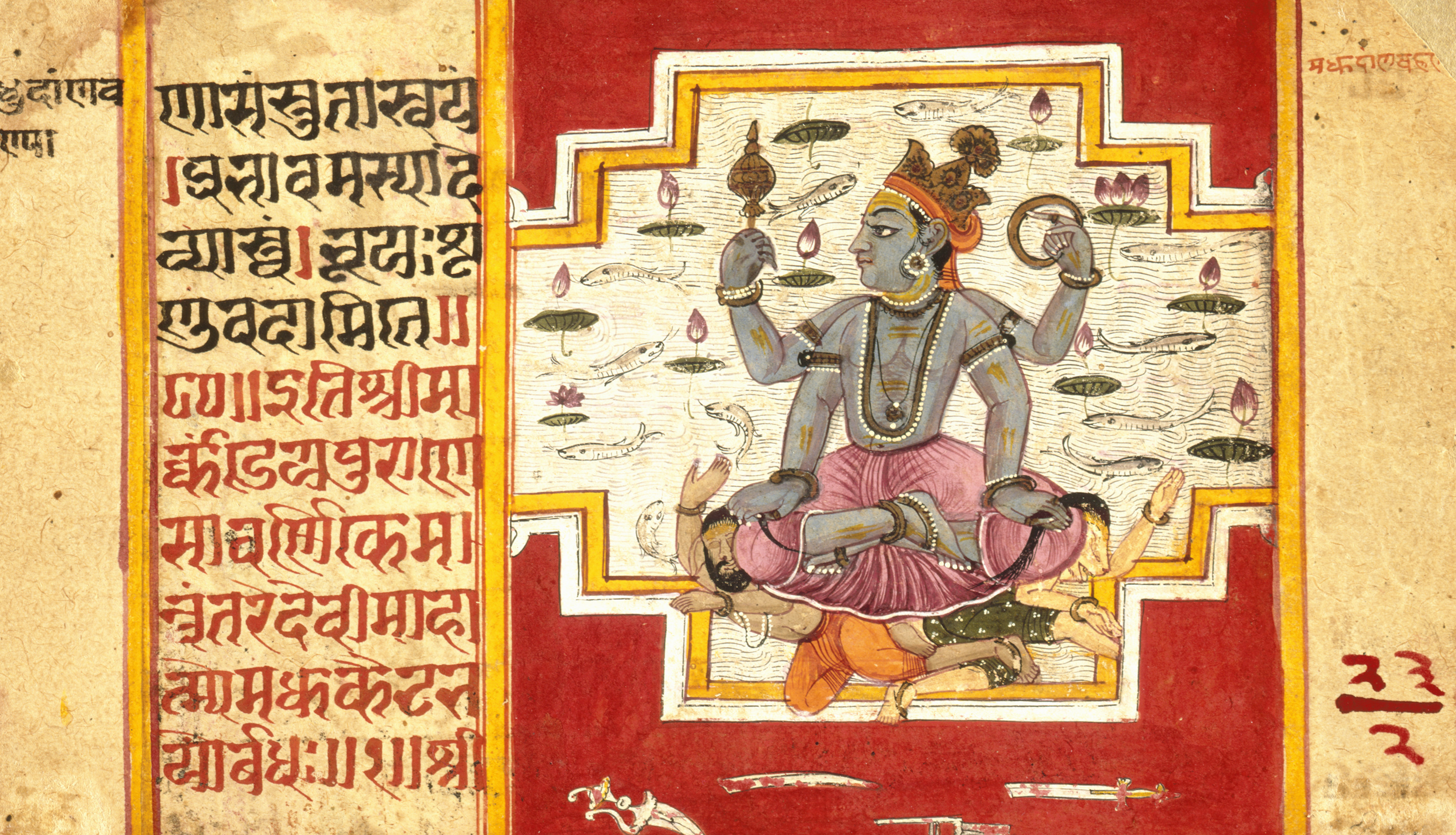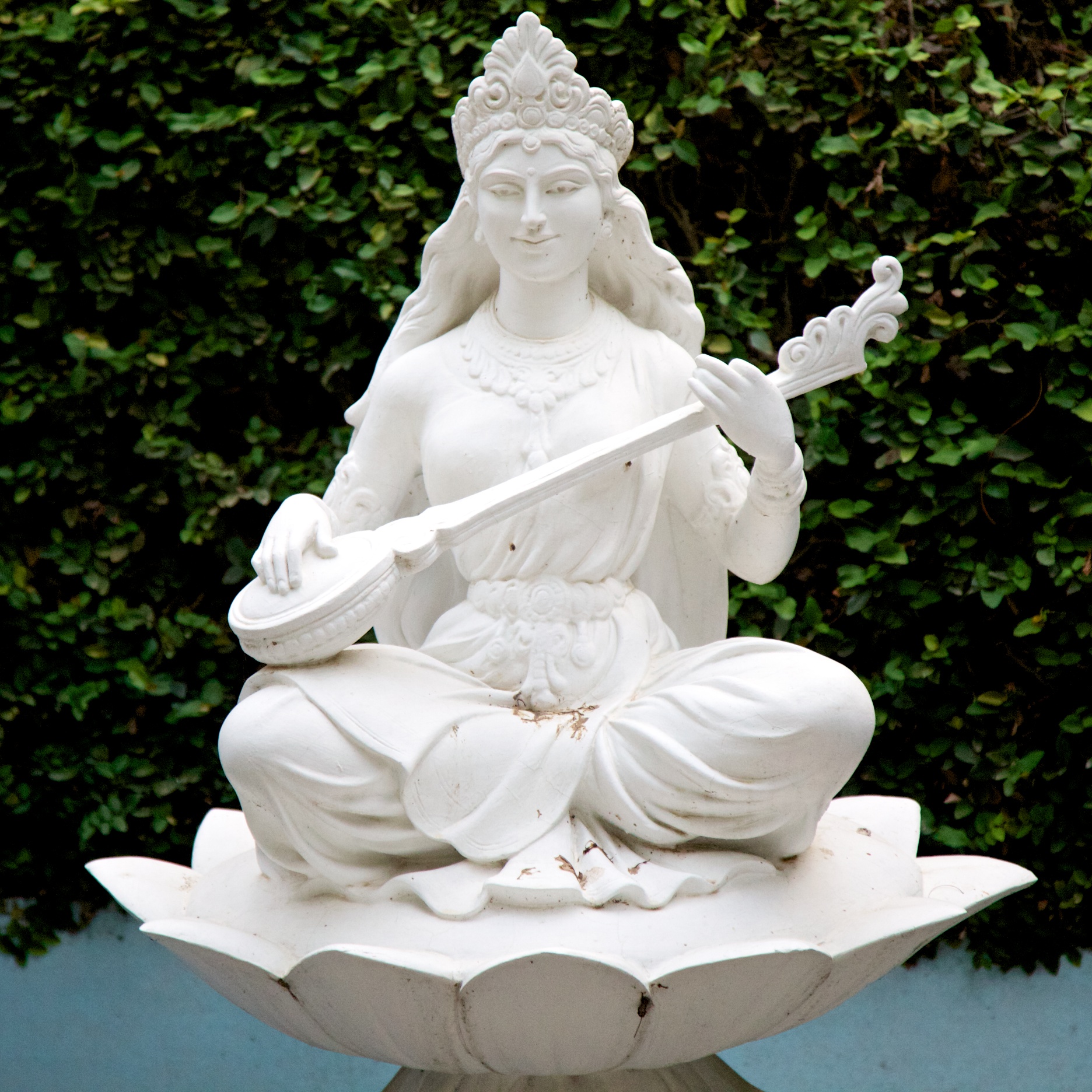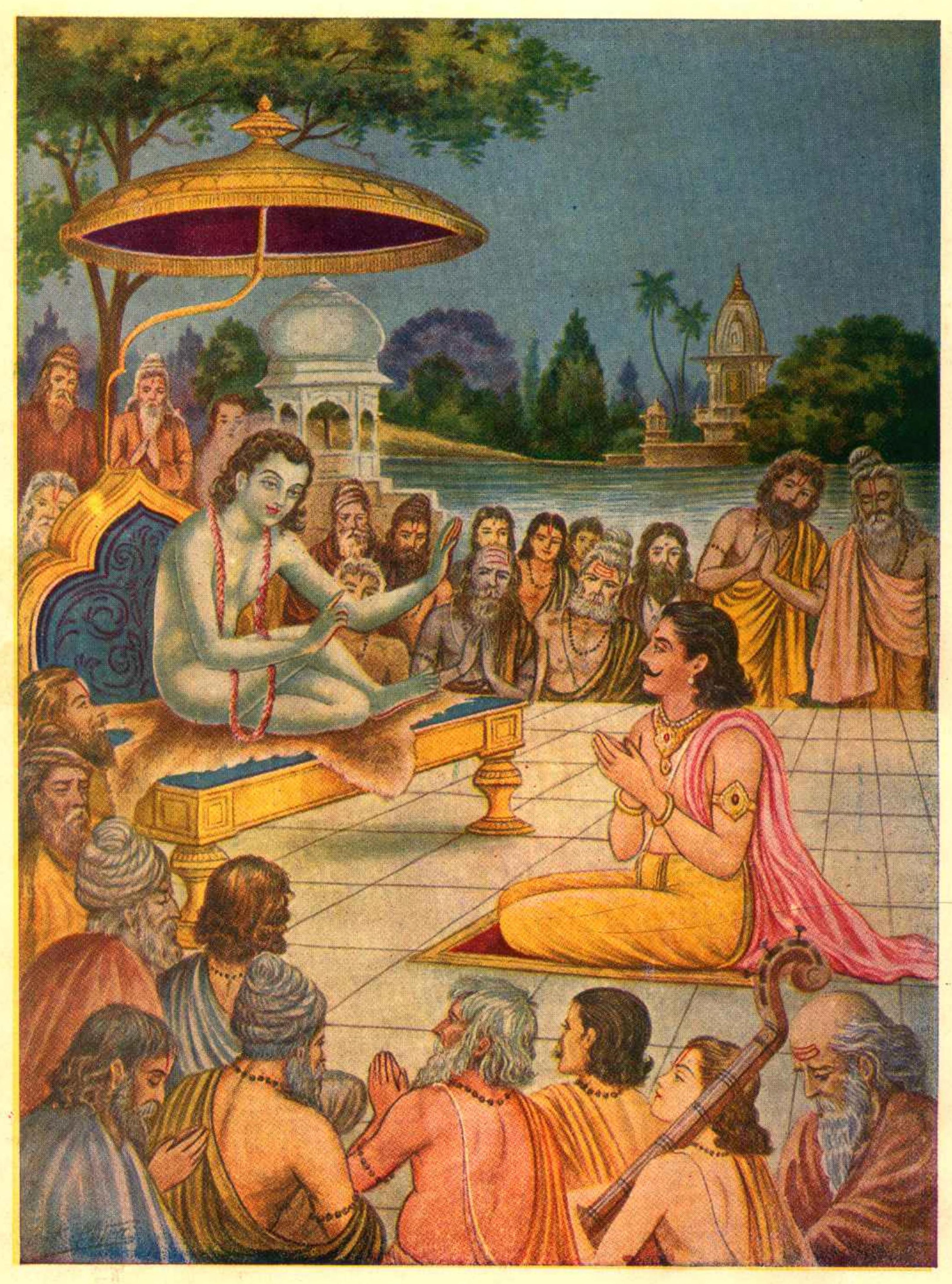|
Madhu-Kaitabh
Madhu (, ) and Kaitabha (, ), also rendered Madhu-Kaiṭabhas, are the names of two asuras in Hindu scriptures, and are associated with Hindu cosmology. Legend Madhu and Kaitabha both originated from the earwax within the deity Vishnu's ears, while he was in the meditative state of yoganidra. From his navel, a lotus sprouted, upon which Brahma, the creator, sat contemplating the creation of the cosmos. Two dewdrops of water upon the lotus were created by Vishnu. One drop was as sweet as honey, and from that drop emerged Madhu, imbued with the attribute of tamas (darkness). The other drop was hard, and from it was born Kaiṭabha, imbued with the attribute of rajas (activity). According to the Devi Bhagavata Purana, Madhu and Kaitabha originated from Vishnu's earwax, and performed a long period of ''tapas'' devoted to the goddess Mahadevi, employing the Vāgbīja mantra. The goddess granted them the boon of death befalling them only with their consent. The proud asuras then st ... [...More Info...] [...Related Items...] OR: [Wikipedia] [Google] [Baidu] |
Madhusudana
Madhusudana () is an epithet of Vishnu or Krishna and is the 73rd name in the Vishnu Sahasranama. According to Adi Sankara's commentary on the Vishnu Sahasranama, Madhusudana means the "destroyer of Madhu". Literature The death of Madhu and the origin of the epithet is described in the Padma Purana The ''Padma Purana'' (, or ) is one of the eighteen Puranas#Mahapuranas, Major Puranas, a genre of texts in Hinduism. It is an encyclopedic text, named after the lotus in which creator god Brahma appeared, and includes large sections dedic ...: References {{VaishnavismCited from ''Sri Vishnu Sahasranama'', commentary by Sri Sankaracharya, translated by Swami Tapasyananda, available at Sri Ramakrishna Math, Chennai; available at aIndian web siteand US site Names of Vishnu Vishnu Hindu mythology Vaishnavism ... [...More Info...] [...Related Items...] OR: [Wikipedia] [Google] [Baidu] |
Devi-Bhagavata Purana
The Devi Bhagavata Purana (, '), also known as the Devi Purana or simply Devi Bhagavatam, is one of the eighteen Mahapuranas as per Shiva Purana of Hinduism. Composed in Sanskrit by Veda Vyasa, the text is considered a major purana for Devi worshippers ( Shaktas). It promotes ''bhakti'' (devotion) towards Mahadevi, integrating themes from the Shaktadvaitavada tradition (a syncretism of Samkhya and Advaita Vedanta). While this is generally regarded as a Shakta Purana, some scholars such as Dowson have also interpreted this Purana as a Shaiva Purana. The Purana consists of twelve cantos with 318 chapters. Along with the ''Devi Mahatmya'', it is one of the most important works in Shaktism, a tradition within Hinduism that reveres Devi or Shakti (Goddess) as the primordial creator of the universe, and as Brahman (ultimate truth and reality). It celebrates the divine feminine as the origin of all existence: as the creator, the preserver and the destroyer of everything, as well ... [...More Info...] [...Related Items...] OR: [Wikipedia] [Google] [Baidu] |
Devi Bhagavata Purana
The Devi Bhagavata Purana (, '), also known as the Devi Purana or simply Devi Bhagavatam, is one of the eighteen Mahapurana (Hinduism), Mahapuranas as per Shiva Purana of Hinduism. Composed in Sanskrit language, Sanskrit by Vyasa, Veda Vyasa, the text is considered a major purana for Devi worshippers (Shaktism, Shaktas). It promotes ''bhakti'' (devotion) towards Mahadevi, integrating themes from the Shaktadvaitavada tradition (a syncretism of Samkhya and Advaita Vedanta). While this is generally regarded as a Shakta Purana, some scholars such as Dowson have also interpreted this Purana as a Shaivism, Shaiva Purana. The Purana consists of twelve cantos with 318 chapters. Along with the ''Devi Mahatmya'', it is one of the most important works in Shaktism, a tradition within Hinduism that reveres Devi or Shakti (Goddess) as the primordial creator of the universe, and as Brahman (ultimate truth and reality). It celebrates the divine feminine as the origin of all existence: as th ... [...More Info...] [...Related Items...] OR: [Wikipedia] [Google] [Baidu] |
Vishnu Madhu Kaitabh
Vishnu (; , , ), also known as Narayana and Hari, is one of the principal deities of Hinduism. He is the supreme being within Vaishnavism, one of the major traditions within contemporary Hinduism, and the god of preservation (sattva). Vishnu is known as ''The Preserver'' within the Trimurti, the triple deity of supreme divinity that includes Brahma and Shiva. Gavin Flood, An Introduction to Hinduism' () (1996), p. 17. In Vaishnavism, Vishnu is the supreme Lord who creates, protects, and transforms the universe. Tridevi is stated to be the energy and creative power (Shakti) of each, with Lakshmi being the equal complementary partner of Vishnu. He is one of the five equivalent deities in Panchayatana puja of the Smarta tradition of Hinduism. According to Vaishnavism, the supreme being is with qualities ( Saguna), and has definite form, but is limitless, transcendent and unchanging absolute Brahman, and the primal Atman (Self) of the universe. There are both benevolent and fe ... [...More Info...] [...Related Items...] OR: [Wikipedia] [Google] [Baidu] |
Sudarshana Chakra
The Sudarshana Chakra (, ) is a divine discus, attributed to Vishnu in the Hindu scriptures. The Sudarshana Chakra is generally portrayed on the right rear hand of the four hands of Vishnu, who also holds the Panchajanya (conch), the Kaumodaki (mace), and the Padma (lotus). In the ''Rigveda'', the Sudarshana Chakra is stated to be Vishnu's symbol as the wheel of time. The discus later emerged as an ayudhapurusha (an anthropomorphic form), as a fierce form of Vishnu, used for the destruction of demons. As an ''ayudhapurusha'', the deity is known as ''Chakraperumal'' or ''Chakratalvar''. Etymology The word ''Sudarshana'' is derived from two Sanskrit words – ''Su'' () meaning "good/auspicious" and '' Darshana'' () meaning "vision". In the Monier-Williams dictionary the word Chakra is derived from the root (''kram'') or (''rt'') or (''kri'') and refers among many meanings, to the wheel of a carriage, wheel of the sun's chariot or metaphorically to the wheel of time. In ... [...More Info...] [...Related Items...] OR: [Wikipedia] [Google] [Baidu] |
Dictionary Of Hindu Lore And Legend
The ''Dictionary of Hindu Lore and Legend'' (2002) is a book written by Anna L. Dallapiccola, and contains information on over one thousand concepts, characters, and places of Hindu mythology and Hinduism, one of the major religions of the Indian subcontinent. The writer has remained associated with the university of Heidelberg, Germany as a Professor of Indian Art; with the University of Edinburgh, Great Britain as Honorary Professor; and with De Montfort University, Leicester Leicester ( ) is a city status in the United Kingdom, city, Unitary authorities of England, unitary authority area, and the county town of Leicestershire in the East Midlands of England. It is the largest city in the East Midlands with a popula ... as a visiting professor. She is a Fellow of the Royal Asiatic Society. Sources References Mythology books Hinduism studies books 2002 non-fiction books {{myth-book-stub ... [...More Info...] [...Related Items...] OR: [Wikipedia] [Google] [Baidu] |
Ikshvaku
Ikshvaku (Sanskrit ; Pāli: ) is a legendary king in Indian religions, particularly Hindu and Jain scriptures Jain literature () refers to the literature of the Jain religion. It is a vast and ancient literary tradition, which was initially transmitted orally. The oldest surviving material is contained in the canonical ''Jain Agamas'', which are wri .... In Hinduism, he is described to be the first king of the Kosala Kingdom, and was one of the ten sons of Shraddhadeva Manu, the first man on the earth. He was the founder and first king of the Ikshvaku dynasty, also known as the Suryavamsha, in the kingdom of Kosala, which also historically existed in ancient India. He had a hundred sons, among whom the eldest was Vikukshi. Another son of Ikshvaku's, named Nimi (Vedic king), Nimi, founded the Kingdom of the Videhas. Rama, Mahavira, and the Gautama Buddha in Hinduism, Buddha are also stated to have belonged to the Suryavamsha or Ikshvaku dynasty. Origin From Kashyapa, th ... [...More Info...] [...Related Items...] OR: [Wikipedia] [Google] [Baidu] |
Mahabharata
The ''Mahābhārata'' ( ; , , ) is one of the two major Sanskrit Indian epic poetry, epics of ancient India revered as Smriti texts in Hinduism, the other being the ''Ramayana, Rāmāyaṇa''. It narrates the events and aftermath of the Kurukshetra War, a war of succession between two groups of princely cousins, the Kauravas and the Pandava, Pāṇḍavas. It also contains Hindu philosophy, philosophical and devotional material, such as a discussion of the four "goals of life" or ''puruṣārtha'' (12.161). Among the principal works and stories in the ''Mahābhārata'' are the ''Bhagavad Gita'', the story of Damayanti, the story of Shakuntala, the story of Pururava and Urvashi, the story of Savitri and Satyavan, the story of Kacha (sage), Kacha and Devayani, the story of Rishyasringa and an Ramopakhyana, abbreviated version of the ''Rāmāyaṇa'', often considered as works in their own right. Traditionally, the authorship of the ''Mahābhārata'' is attributed to Vyasa, Vy ... [...More Info...] [...Related Items...] OR: [Wikipedia] [Google] [Baidu] |
Yogamaya
Yogamaya (, ) is a Hinduism, Hindu goddess who serves as the personification of Vishnu's powers of illusion. In Vaishnavism, Vaishnava tradition, she is accorded the epithet Narayani—"the sister of Narayana (Vishnu)"—and is regarded as the benevolent aspect of the goddess Durga. According to Hindu texts, Yogamaya plays the role of the facilitator of the earthly birth of Krishna, an incarnation of Vishnu. She took the avatar of the daughter of Yadava cowherd Nanda (Hinduism), Nanda and Yashoda, after which her place is swapped with Krishna to protect the latter from the tyrant ruler Kamsa. After warning Kamsa about his impending death, Yogamaya vanished and resided in the Vindhya Range, Vindhya hills, due to which she is accorded the epithet Vindhyavasini. Yogamaya is also an important goddess in Shaktism sect, and is worshipped as a form of Mahadevi. Etymology Yogamaya refers to “the internal potency of Vishnu, Bhagavan, that arranges and enhances all his pastimes� ... [...More Info...] [...Related Items...] OR: [Wikipedia] [Google] [Baidu] |
Hayagriva
Hayagriva ( IAST , ) is a Hindus, Hindu deity, the horse-headed avatar of Vishnu. The purpose of this incarnation was to slay a Danava (Hinduism), danava also named Hayagriva (A descendant of Kashyapa and Danu), who had the head of a horse and the body of a human. Iconography Hayagriva is an avatara of the god Vishnu. He is worshipped as the god of knowledge and wisdom, with a human body and a horse's head, brilliant White horse (mythology), white in color, with white garments and seated on a white Nelumbo nucifera, lotus. Symbolically, the story represents the triumph of pure knowledge, guided by the hand of Divinity, over the demonic forces of passion and darkness. Vedanta Desika's ''dhyāna-śloka'' (meditative verse) on Hayagriva typifies this deity's depiction in Hindu iconography: He has Chaturbhuja, four hands, with one in the mode of bestowing knowledge; another holds books of wisdom, and the other two hold the Shankha, Conch and Sudarshana Chakra, Discus. His be ... [...More Info...] [...Related Items...] OR: [Wikipedia] [Google] [Baidu] |
Vedas
FIle:Atharva-Veda samhita page 471 illustration.png, upright=1.2, The Vedas are ancient Sanskrit texts of Hinduism. Above: A page from the ''Atharvaveda''. The Vedas ( or ; ), sometimes collectively called the Veda, are a large body of religious texts originating in ancient India. Composed in Vedic Sanskrit, the texts constitute the oldest layer of Sanskrit literature and the oldest Hindu texts, scriptures of Hinduism. There are four Vedas: the Rigveda, the Yajurveda, the Samaveda and the Atharvaveda. Each Veda has four subdivisions – the Samhitas (mantras and benedictions), the Brahmanas (commentaries on and explanation of rituals, ceremonies and sacrifices – Yajñas), the Aranyakas (text on rituals, ceremonies, sacrifices and symbolic-sacrifices), and the Upanishads (texts discussing meditation, philosophy and spiritual knowledge).Gavin Flood (1996), ''An Introduction to Hinduism'', Cambridge University Press, , pp. 35–39A Bhattacharya (2006), ''Hindu Dharma: Introduc ... [...More Info...] [...Related Items...] OR: [Wikipedia] [Google] [Baidu] |
Bhagavata Purana
The ''Bhagavata Purana'' (; ), also known as the ''Srimad Bhagavatam (Śrīmad Bhāgavatam)'', ''Srimad Bhagavata Mahapurana'' () or simply ''Bhagavata (Bhāgavata)'', is one of Hinduism's eighteen major Puranas (''Mahapuranas'') and one of the most popular in Vaishnavism. Composed in Sanskrit and traditionally attributed to Veda Vyasa, it promotes '' bhakti'' (devotion) towards Krishna, an avatar of Vishnu, integrating themes from the Advaita (monism) philosophy of Adi Shankara, the Vishishtadvaita (qualified monism) of Ramanujacharya and the Dvaita (dualism) of Madhvacharya. It is widely available in almost all Indian languages. The ''Bhagavata Purana'', like other puranas, discusses a wide range of topics including cosmology, astronomy, genealogy, geography, legend, music, dance, yoga and culture. As it begins, the forces of evil have won a war between the benevolent '' devas'' (deities) and evil '' asuras'' (demons) and now rule the universe. Truth re-emerges as ... [...More Info...] [...Related Items...] OR: [Wikipedia] [Google] [Baidu] |








